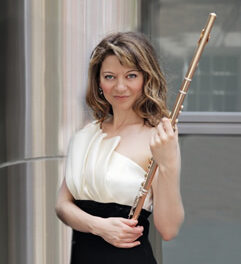A haiku review of the October 5 performance of Giacomo Puccini’s Tosca by the Piedmont Opera Company in Stevens Center would be “Wow!” Seldom do so many details of a production and so many soloists’ mastery of both the vocal and dramatic demands of their roles combine to produce so fine an evening in the theatre.
With no jarring “updating” of time or place, Joseph Bascetta’s stage direction was as traditional as it was dramatically effective. Convincing realistic scenery provided by Tri-Cities Opera made a fine backdrop for the rather small stage of Stevens Center. It was expertly lit by Norman Coates. The use of back lighting as Tosca left Scarpia’s apartment was memorable. The make-up and wigs by Michael Meyers were very good, withstanding scrutiny from Row F. Stevens Center makes any string group sound bigger and better. Like Asian rice paddies on mountains, the orchestra pit is terraced, and it held a reduced number Winston-Salem Symphony players. The roughly four members each for the two violin sections, violas and cellos with two basses sounded positively plush.
All important orchestra solos came off well. Sally Peck’s viola accompanied by Kathryn Levy’s flute and Sally Duran’s harp evoked the baroque viol ensemble in the “cantata” portion of Act II. The horns were rousing in Act III. William Boggs, Artistic Director of Opera Columbus, led a fast paced performance that swept ever forward. The small chorus and Central Carolina Children’s Chorus were effective.
Soprano Robin Follman was superb as the passionate singer Floria Tosca. Her full and warm dramatic soprano voice was evenly supported throughout its range. Her diction was superb and she brought the jealous but loving character fully to life. Act I featured her irrational jealousy, her contempt for the honeyed manner of Scarpia, and the growing poison of his insinuations. Act II was perfect, showing her ever tightening desperation and her horror for her unavoidable, violent act. Act III ended with her singing Tosca’s last line…, sometimes just shouted. It did not hurt that hers was a stunningly gorgeous presence, too.
As the ominous and venal Baron Scarpia, baritone Robert W. Overman matched her in artistry, singing the finest live performance of the role I have heard to date. His firm and evenly supported voice always seemed to have plenty of capital in reserve. His embodiment of Scarpia’s public veneer, barely covering the sadistic rapist beneath, was perfect. The evil was slowly revealed over the course of Acts I-II, culminating in the monologue “Ella verrà….”
Opposite such strongly voiced artists, the pleasant tenor of Jose Luis Duval as Cavaradossi seemed of lighter weight. He sang without strain, but one sensed less vocal capital in reserve. He did come through with good dramatic highs at crucial points such as “Ah c’è un Dio vendicator!,” when news of the defeat of Royalist forces at Marengo arrived, and his duets with Tosca were well blended. One was more conscious of his singing the role than of his living the role completely, as his colleagues did.
Outstanding among the character role singers was the large, deep, rich bass of John Fortson as Angelotti. His other, doubled role, as the Jailer, gave less scope. Bass Jason Budd was excellent as the troublesome Sacristan. Like a well-fed Death with an eye patch, tenor Steve LaCrosse was a very threatening Spoletta. A.J. Fletcher scholar Krassen Karagiozov did fine in the baritone role of Sciaronne, which gives little room to shine. The evocative off-stage voice of the young shepherd heard in the opening of Act III was that of soprano Jennifer Delatte, a member of the chorus.











